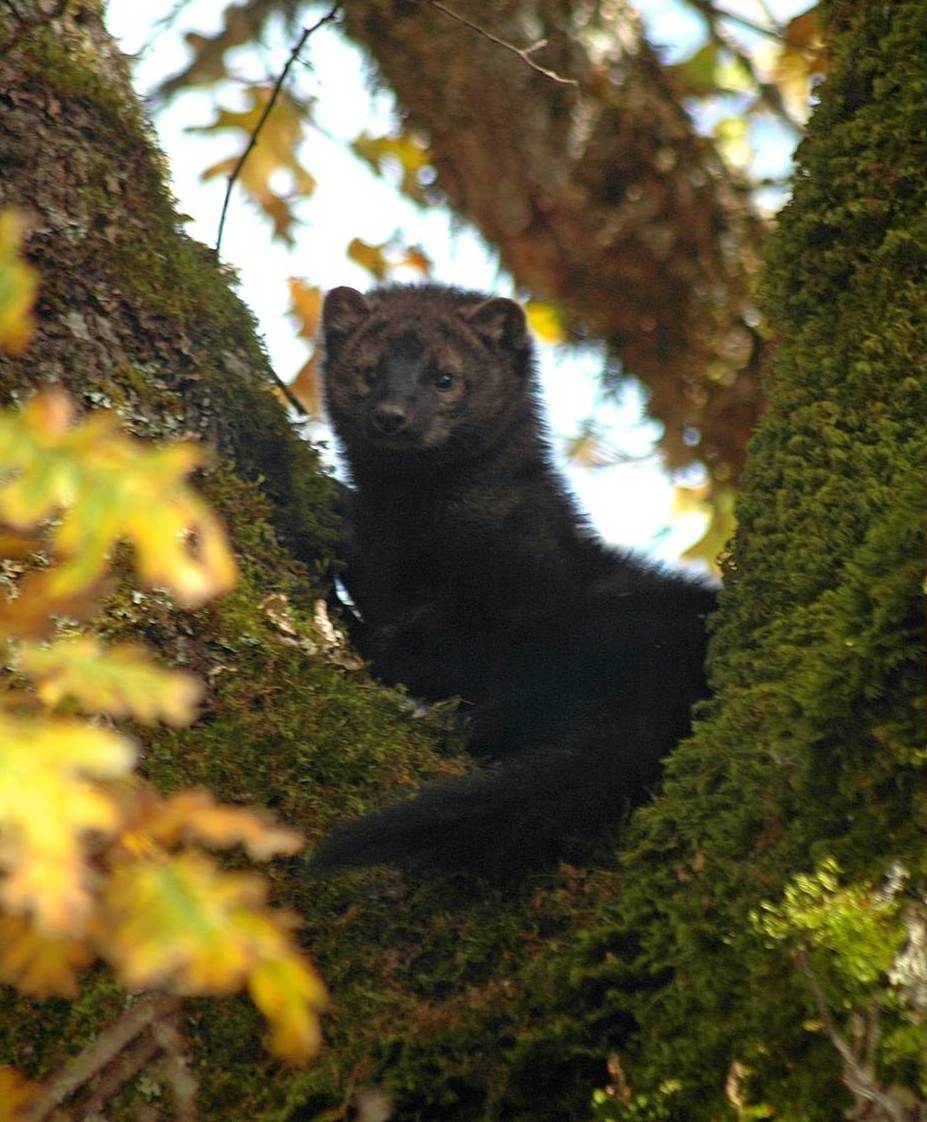by Joe Eaton

Pacific fisher in tree (Photo: J.M. Higley)
(Full article from RATS Tales January 2023)
In the parlance of social media, fishers—dense-furred weasel relatives of northern and western forests—appear to be trending. Hot on the heels of a recent study (funded in part by RATS) of anticoagulant rodenticide (AR) exposure in fishers in Washington’s Cascade Range, comes fresh data from five northeastern states: Maine, Vermont, New Hampshire, New York, and Pennsylvania.
At The Wildlife Society’s (TWS) annual conference last November, researcher Georgianna Silveira presented preliminary findings from an analysis of AR exposure in fishers trapped for their fur, using trapping reports from the last two decades. Georgianna is a graduate student at the SUNY/State University of New York College of Environmental Science and Forestry.
The new data point to a relationship between the number of AR compounds found in the fishers’ livers and the likelihood that local populations have declined. Significantly, this is one of only a handful of studies so far (others have dealt with Eurasian kestrels in Great Britain and red foxes in France) that indicate population-level effects of AR exposure. Silveira also said that spatial patterns implicate AR use in the wildland-urban interface as a factor; however, as in the Washington study, sources and pathways remain to be clarified.
Fishers once ranged through boreal forests from coast to coast. Like beavers and other furbearers, they were heavily impacted by unregulated trapping. Logging also reduced their preferred habitat. By the early 1900s fishers had been extirpated from most of the US and eastern Canada, or reduced to small remnants in New York’s Adirondacks and elsewhere. After trapping was restricted in the 1930s, eastern populations rebounded; fishers were successfully reintroduced to some northeastern states. With translocations from northern New York and New Hampshire from 1994-98, Pennsylvania, for one, saw exponential fisher population growth and colonization of most of the state’s forests. These trends were used to justify the resumption of trapping, except for specific closed areas in Pennsylvania and New York.
New threats emerged, though. Declines were reported in the Adirondacks. When radio-collared fishers in a New York project were found dead with relatively minor injuries and AR residues in their livers, Silveira and other SUNY researchers decided to pull together data on trapping and AR exposure in New York and neighboring states and look for evidence of population-level effects.
Overall, 285 trapped fishers from the five states were screened for ARs. The number of compounds in liver tissue was used as a metric for exposure. In each state, over half of the fishers were positive for at least one AR; exposure ranged from 56 percent in Maine to 100 percent (of 30 samples) in Vermont. Silveira said a “strong geographic pattern of exposure” emerged, highest in southern New Hampshire and Vermont, much lower in northern Maine and parts of western New York and Pennsylvania.
To quantify population trends, the researchers used fur harvest records from state wildlife agencies. Time periods varied from state to state (as far back as 1990 for Vermont, only from 2011 for Maine), as did the way catch was reported. But the scientists found a way to calculate the probability that catch per unit effort, a measure that originated in fisheries science, was declining over time in a given geographic area, which was then compared with AR exposure. They found that the higher the exposure level, the greater the probability of a declining catch. “We were surprised to see such a strong initial relationship,” Silveira said in her TWS presentation. “It potentially indicates that rodenticide exposure is an important driver of population decline.”
While the Washington study didn’t detect a relationship between AR exposure and proximity to developed areas, the northeastern data told a different story. In coverage of her presentation on the TWS web site, Silveira was quoted as saying : “It looks like proximity to built environments, specifically structures, not agricultural buildings, are driving exposure,” adding that the issue seemed to arise most in isolated areas surrounded by wild land.
If that’s where northeastern fishers are being exposed, what’s the pathway?
Although reputed to specialize in preying on porcupines, fishers are versatile hunters and dietary generalists. Diet studies in Washington and California reveal diverse mixes of mammal and bird prey in different locations, even within the Cascade Range. One measure of what northeastern fishers are eating is a 2017 paper by Darin J. McNeil Jr. of Indiana University of Pennsylvania and colleagues, cataloging the stomach contents of 91 fishers trapped or found dead in 32 Pennsylvania counties. The most common species whose remains were identified were white-tailed deer (probably scavenged, although fishers have been reported to kill fawns), cottontail rabbits, and, surprisingly, other fishers (in 12 per cent of the samples). Porcupines ranked high, along with a roster of other rodents (voles, woodrats, deer mice, squirrels), fellow carnivores (raccoon, red fox, striped skunk), bats, birds (pheasant, chickadee, woodpecker), snakes, frogs, and fish.
Not found: the commensal rodent pests—brown and black rats, house mice—that are the usual targets of ARs. If the diet of the Pennsylvania fishers is representative for the northeastern states, exposure may involve eating either non-target rodents that accessed poisoned bait, or carnivores like raccoons or skunks that consumed poisoned rodents.
Tracing exposure pathways is one likely direction for future research. Silveira said she and her follow researchers plan to look at other potential drivers of population decline, like the availability of suitable forested habitat and nesting and denning sites. Still, she saw the preliminary findings as a red flag: “The initial results are really concerning to us and potentially suggest that rodenticides are having negative effects on fishers at the regional level in the northeastern US.”
